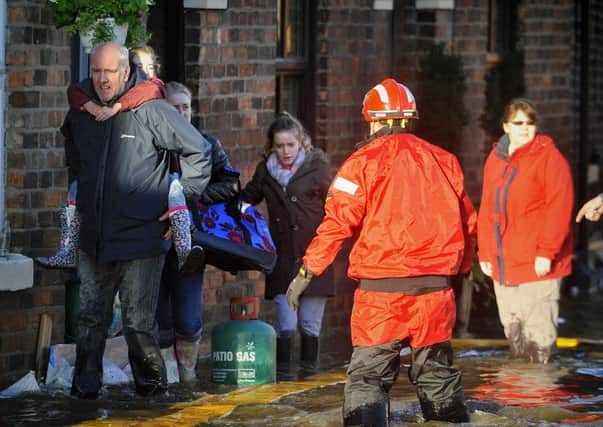Sir James Bevan: Why we must all work together to fight the floods


In Leeds, York and the Calder Valley, I saw the damage and suffering at first hand. It made me even more determined to do all we can to protect people against the devastation and heartbreak flooding causes.
I know that every time a house or a business floods it is a personal tragedy. So we are always looking at what we can do to improve the service we deliver to the public here in Yorkshire and beyond: repairing, maintaining, upgrading and adding to those flood defences that help to reduce the risk of water ending up in your street, in your house.
Advertisement
Hide AdAdvertisement
Hide AdWe can never prevent all flooding. But by working together we can reduce the risks of it happening, and the extent and damage when it does. Fighting flooding is everyone’s responsibility – the Environment Agency, local authorities, businesses, communities, individual householders, yours.
The Environment Agency builds and operates flood defences; warns and informs communities at risk; and when flooding happens, we put our people on the ground to help protect and support those affected.
But managing your own flood risk is your responsibility too. One in six properties in Yorkshire is at risk of flooding. If you live in a flood risk area, you need to know if your house is at risk and you need to know what to do to reduce that risk. So please do check on our new website – https://floodsdestroy.campaign.gov.uk.
We are doing our bit too, by working with local partners on new or improved flood alleviation schemes across Yorkshire. This financial year, the Environment Agency is spending £73m on schemes to provide protection against flooding and coastal erosion in Yorkshire. By the end of this year, approximately 9,000 homes and businesses in Yorkshire will be better protected.
Advertisement
Hide AdAdvertisement
Hide AdOur work this year included upgrading the Foss Barrier in York, part of a wider long-term plan to reduce flooding to that historic and beautiful city. Last month marked a milestone in the £17m programme of improvements as the installation of the last of eight new, high capacity pumps was completed.
In Leeds, we are working in partnership with Leeds City Council on a major new flood alleviation scheme. Phase One, costing some £50m, is one of the largest river flood defence schemes in the country. It comprises major construction work along the River Aire in the city centre and Holbeck extending a distance of more than three miles between Leeds train station and Thwaite Mills. Phase Two will focus on catchment-wide flood alleviation along the River Aire.
Calderdale was badly hit in December. We have spent £9m to repair defences there to ensure that communities affected by flooding last winter now have at least the same level of flood protection they had before winter 2015/16. And we are working with the local communities in Mytholmroyd, Hebden Bridge and elsewhere to improve their flood defences, with £35m of new funding agreed since the December 2015 floods.
Hull was spared major flooding in December, and the spectacular Hull Barrier helps protect the city. But large areas were flooded in 2007 and £36m has been allocated to improve flood defences in Hull and on Humberside.
Advertisement
Hide AdAdvertisement
Hide AdIn Sheffield, we are currently working in partnership with Sheffield City Council on a £19m project to help alleviate flooding in the Lower Don Valley. Due to complete in summer 2017, this forms the first part of a multi-million pound investment in flood risk reduction from the Peak District hills to the city centre by 2021.
But it is not all about building barriers and higher walls. Yorkshire is leading the way in working with nature to reduce flood risk. This year I visited the pioneering natural flood risk management scheme in Pickering, which local people have designed and delivered with Environment Agency support.
By using natural methods – such as by planting trees to reduce the speed of water running off the nearby hills and creating leaky dams in rivers – together with a flood basin which holds water in time of high rainfall, Pickering has a scheme that is a model for others. It has been calculated that during the December floods, it reduced river peak flow by around 15-20 per cent. We are keen to learn the lessons from this ground-breaking initiative, to use more natural flood management in our own schemes in future.
There is a lot more for all of us to do to reduce flood risk. But we have come a long way in the last two decades. As a nation, we are getting better at protecting ourselves. Flood defences cannot protect everyone all the time, but they do protect hundreds of thousands of people.
Advertisement
Hide AdAdvertisement
Hide AdEvery time there is heavy rain or a high tide, our flood defences keep people in Yorkshire safe and dry. Since 2003, investment in flood defence has better protected more than 500,000 homes across the country. We will continue to do our very best to help Yorkshire fight flooding. Please do what you can too, to help protect yourself and your home. The best way to fight flooding is to do it together.
Sir James Bevan is chief executive of the Environment Agency.